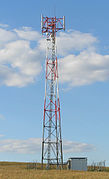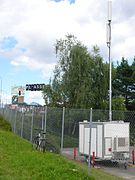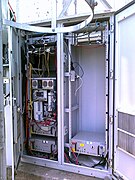|
Base transceiver stationA base transceiver station (BTS) or a baseband unit[1] (BBU) is a piece of equipment that facilitates wireless communication between user equipment (UE) and a network. UEs are devices like mobile phones (handsets), WLL phones, computers with wireless Internet connectivity, or antennas mounted on buildings or telecommunication towers. The network can be that of any of the wireless communication technologies like GSM, CDMA, wireless local loop, Wi-Fi, WiMAX or other wide area network (WAN) technology. BTS is also referred to as the node B (in 3G networks) or, simply, the base station (BS). For discussion of the LTE standard the abbreviation eNB for evolved node B is widely used, and GNodeB for 5G. Though the term BTS can be applicable to any of the wireless communication standards, it is generally associated with mobile communication technologies like GSM and CDMA. In this regard, a BTS forms part of the base station subsystem (BSS) developments for system management. It may also have equipment for encrypting and decrypting communications, spectrum filtering tools (band pass filters) and so on. Antennas may also be considered as components of BTS in general sense as they facilitate the functioning of BTS. Typically a BTS will have several transceivers (TRXs) which allow it to serve several different frequencies and different sectors of the cell (in the case of sectorised base stations). A BTS is controlled by a parent base station controller via the base station control function (BCF). The BCF is implemented as a discrete unit or even incorporated in a TRX in compact base stations. The BCF provides an operations and maintenance (O&M) connection to the network management system (NMS), and manages operational states of each TRX, as well as software handling and alarm collection. The basic structure and functions of the BTS remains the same regardless of the wireless technologies. General architectureA BTS is usually composed of:
Terms regarding a mobile BTS
Directional antennas reduce LoRa (long-range) interference. If not sectorised, the cell will be served by an omnidirectional antenna, which radiates in all directions. A typical structure is the trisector, also known as clover, in which there are three sectors served by separate antennas. Each sector has a separate direction of tracking, typically of 120° with respect to the adjacent ones. Other orientations may be used to suit the local conditions. Bisectored cells are also implemented. These are most often oriented with the antennas serving sectors of 180° separation to one another, but again, local variations do exist. GallerySee alsoFurther reading
External linksWikimedia Commons has media related to Mobile phone base stations. References
|




